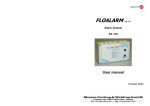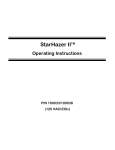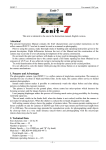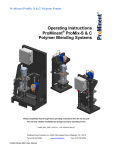Download Floswitch
Transcript
FLOSWITCH User manual rel. 1.0 July 2003 Messer Cutting & Welding GmbH Lärchenstr. 139a - 65933 Frankfurt / Main – Germany Tel. +49-(0)69-38016-226 ∗ Fax +49-(0)69-38016-200 2 TABLE of CONTENTS PREVIEW................................................................................................................. 4 INSTALLATION ..................................................................................................... 4 Earth................................................................................................................... 4 Backup battery.................................................................................................... 4 KEYBOARD OPERATION.................................................................................... 5 MAINTENANCE................................................................................................... 6 MANUAL SWITCH OVER................................................................................... 7 PROGRAMMING.................................................................................................. 7 System configuration .......................................................................................... 7 Plant configuration............................................................................................. 8 Input Setup........................................................................................................ 10 ERASING SETUP PARAMETERS..................................................................... 12 FUNCTIONS .......................................................................................................... 12 MONITORING ......................................................................................................... 12 ALARMS MANAGEMENT ........................................................................................ 13 FAILS ..................................................................................................................... 14 SHUT-OFF .............................................................................................................. 15 HALT ..................................................................................................................... 15 MOUNTING ........................................................................................................... 16 ELECTRICAL CONNECTIONS ......................................................................... 17 TYPICAL APPLICATIONS ................................................................................. 18 TECHNICAL CHARACTERISTICS .................................................................. 19 3 PREVIEW FLOSWITCH is versatile fully-programmable equipment, managing following functions: • Automatic control of two different switch-over systems • Logic control of pneumatic valves • Status, measurement and alarm monitoring • Emergency shut-off The I/O provision includes four 4-20mA inputs, ten ON/OFF inputs and four solenoid valves; in addition, each input can be configured as status (digital), measurement (analog) or alarm with or without memory. Each output solenoid valve can perform switch-over, logic or shut-off functions. INSTALLATION The housing of FLOSWITCH unit is IP 55 plastic box for wall mounting. Outside, the equipment must be protected from direct sun and rain. Technical information concerning cabling, mounting and further details are shown in outlines at the bottom of the manual. Earth FLOSWITCH unit needs an earth connection to protect the circuitry from surges generated by electrical discharges coming from power and phone networks (see connection layout). To safeguard the equipment from over-voltages and for safety reasons, the earth connection must exist always and obligatorily. The builder denies all responsibilities for whichever damage to people and things, including equipment, due to fault of earth connection. Backup battery A NiCd backup accumulator, disconnected at the delivery, maintains data in memory and real time clock function during about thirty days. Turn on the switch labeled BATTERY, located in the rear of the front panel, to connect the backup battery, before the first power-up. 4 KEYBOARD OPERATION Programming, verify and command functions are performed by five keys located on the front panel, through a number of menus. PASSWORD Push Ö over two seconds: system will require the password before entering into programming mode. Press Ö to select the desired character, Ø × to modify it, Õ to delete the character left. The password authorization can be skipped by setting the keyword to blank (see the following section). PASSWORD 0000 MAIN >Maintenance Manual switch over Setup Exit After entering the correct password, push to confirm and open the MAIN menu, activating the programming status. ACK In programming mode, keys assume following functions: Ö • Move the cursor on the right character (editing mode only) Õ • Erase the left character (editing mode only) ACK • • • • Execute selected command Open selected menu Open editing mode of selected parameter Close editing mode and accept the selected value 5 Ø× • Scroll and select menus • Select parameter values • Increase/decrease numerical values • Set characters during editing of alphanumerical fields In practice, whatever editing sequence includes following steps: 1) 2) 3) 4) Select desired menu or parameter using Ø × Open editing of menu or parameter, by pushing ACK If necessary, repeat steps 1 and 2 until the desired parameter is reached In editing mode a. press Ø × to select the desired option; b. press Ø to decrease, × to increase numeric values; c. press Ö to move the cursor on the character right of an alphanumeric field (after reaching the rightmost character, a further pushing of same key will move the cursor to first character left cursor wrap-around), press Ø × to modify, press Õ to delete the character left. 5) Press ACK to confirm the entry and close the editing System returns in running mode by selecting the Exit option from main menu, or by keyboard time-out of 60 seconds. MAINTENANCE Opening the MAINTENANCE menu, the status of solenoid valves can be directly controlled. Valves remain in the imposed status until the menu is leaved, then the system return in automatic running mode. Editor time-out in MAINTENANCE menu is inhibited; hence the system can be indefinitely leaved in maintenance mode. MANUAL EV DRIVE >EV1: ON(OFF) EV2: ON(OFF) EV3: ON(OFF) EV4: ON(OFF) Exit 6 1) 2) 3) 4) Select desired solenoid valve using Ø × Press ACK to open the editing Press Ø × to switch the status Press ACK to confirm and close the editing MANUAL SWITCH OVER The manual switch over command allows changing the current supplying bundle; effects of this command continue even after leaving the programming mode. MANUAL SWITCH OVER Ident. L1: 1) Select L1 or L2 using Ø × Right 2) Press ACK to open the editing Ident. L2: 3) Press Ø × to switch the supplying bundle Left 4) Press ACK to confirm and close the editing Exit Note: if the switch over is not possible (for instance because of bundle exhaustion or plant shut-off status, or because a plant is not properly configured), no operation is allowed; in this case the item no way appears right the corresponding identifier. PROGRAMMING SETUP >System Plant 4/20mA Inputs ON/OFF Inputs Exit Select the Setup option from the MAIN menu and press ACK to open the SETUP menu. System configuration SYSTEM CONFIG >Buzzer Volume: Recovery Time: Relay mode: Language: Password: Exit Buzzer volume The variable defines the buzzer volume: valid settings are numeric values from 0 to 10; 0 corresponds to buzzer disabled. Recovery time This function reactivates the acoustic signal and resends the acknowledged alarm status into the unacknowledged condition, if this persists longer than the recovery time. Valid range is from 0 to 99 minutes; (0 = recovery function disabled). 7 Relay mode Following operations are available for the relay output switch: CNO (cumulative alarm normally open): relay energized by alarm, shut-off and halt status • CNC (cumulative alarm normally closed): relay de-energized by alarm, shut-off and halt status • CAS (continuous auxiliary siren): relay follows the status of the internal alarm sound generator. • Language Following languages are available: • English • Italian Password This option allows set or modify the keyword. The password authentication can be skipped setting the keyword to blank. PLANT CONFIG >Type: L1,EV3,EV4 L1 switch-over L1 shut-off EV3 EV4 Exit Plant configuration The contents of this menu differ in functions of the option selected in TYPE parameter. Two lines are related to each switch-over system, respectively for plant and shut-off configuration; only one configuration line is associated to each available solenoid valve. Type Define the control functions of FLOswitch. EV1…4 - All EVs for logic control or shut-off function L1, EV3, EV4 - One switch-over system, EV3 and EV4 available for logic control or shut-off function • L1, L2 - Two switch over systems • • 8 L1 SWITCH-OVER >ID: Control: Priority: Exit ID Alphanumeric string, with maximum length 16 characters, that identifies the switch-over system. It is recommended to use same name for identifier and gas or mixture supplied by the switch over system. Control Devices for bundles level checking. Select ON/OFF for switch sensors, 4/20 mA for transducers. Priority Bundle that supplies at first system startup and whenever the control logic has no other criteria. Select LEFT or RIGHT. EV1 CONTROL >ID: Mode: ON by: Power up: [input list]: Exit ID Alphanumeric string with maximum length of 16 charters identifying the function of the solenoid valve. Mode Select the function associated to the solenoid valve: LOGIC or SHUT-OFF. ON by Logic relation, among the selected inputs, that energizes the solenoid valve. Option “one input” energizes the solenoid valve when one or more inputs among those selected become active (logical OR function). The option “all inputs” energizes the solenoid valve only when all selected inputs become active (logical AND function). This entry is available only if MODE is set to LOGIC; the logic relation for the SHUT-OFF cannot be modified by user (see section SHUT-OFF). The active input condition corresponds to: • Close if NO, open if NC for digital inputs (ON/OFF) • Value outside thresholds for analog inputs (4/20mA) 9 Power up This entry is available only if MODE is set to shut-off function after each power up. SHUT-OFF and activates the [input list] Input list shows the identifiers of all enabled inputs (see INPUT SETUP menus). Switch the field YES/NO of the corresponding input to include/exclude it from the logical or shut-off function. L1 SHUT-OFF This menu defines the input conditions >Power up: [input list]: determining the switch-over system shut-off. Exit The function is identical to that already described for a single solenoid valve. Refer to EV CONTROL CONFIG menu for further details. Input Setup The menu allows defining all parameters concerning analog and digital inputs, including transmitters, sensors and 4/20mA INPUT SETUP functions. >Input Input Input Input Exit 1 2 3 4 √ √ The check-symbol √ indicates the corresponding input is already enabled. Select the desired input and then press ACK to configure it. 4/20mA IN1 CONFIG >Enable: ID: Unit Zero Full Scale Tare Function: Alarm delay: Min alarm Max alarm Exit 4/20 mA INPUTS Enable Switch to enable or disable the input. Identifier Alphanumeric string, with maximum length 8 charters, defining the measurement associated to the input. Unit Measurement units associated to the input. Following options are available: %, Kg, ton, bar, mbar, pH. 10 Zero – Full Scale Range of the transducer, defined with measurement units selected through Unit item. Zero and FS values correspond to the measurements supplied by the analog transducer when the output current is respectively 4 and 20 mA. Valid range is from -1000.0 to 1000.0 with fixed decimal point. Tare Weight of the cylinder empty, expressed in the selected measurement units. The field appears only when measurement units are set to Kg or ton. Function Function associated to the input. the input does not generate ALARM status MEASURE the active status of the input generates ALARM status ALARM ALARM + MEM the active status of the input sets ALARM status and this ends after the following two conditions are verified: user acknowledgement and input come back to normal status. Alarm delay Minimum duration of the alarm condition (signal outside alarm thresholds) before generating the alarm status, expressed in seconds. Valid values range from 0 to 99 seconds. Min – Max alarm Minimum and maximum alarms thresholds. Values must be set within the interval Zero – FS and so that Max is greater than Min. ON/OFF INPUTS ON/OFF INPUT SETUP >Input 1: .... Input 10: Exit This page is similar to the ANALOG INPUT SETUP PAGE, but refers to digital inputs instead of analog inputs. Select the desired input and press ACK to open its configuration page. 11 ON/OFF IN1 CONFIG >Enable: ID: Normally: Function: Alarm delay: Exit For remaining configuration. fields, Normally Normal status of the input, corresponding to OFF and/or non-alarm condition. Set NO for normally open, NC for normally closed. refer to previous section 4/20mA inputs ERASING SETUP PARAMETERS Setup parameters are stored in a non-volatile memory and retained also in power-off condition, without time limits. All current setup parameters can be erased and set to default values by pressing the pushbutton behind the front panel, close to the battery switch. FUNCTIONS Monitoring In absence of alarm or shut-off status, the display shows monitoring pages, containing up to four measurements and/or states. In case the number of signals exceeds four, the display will show more monitoring pages in sequence, alternating them each 5 seconds. The monitoring criterion consists of minimizing the number of pages, by filling the display as far as possible. For example, configuring only one analog and tree digital signals, only one monitoring page will suffice for all information. Some typical monitoring pages are shown below. First power-up FLOWSWITCH No configured inputs 12 No measurement neither status FLOWSWITCH No alarm ID ID ID ID Measurements only An.1 value 1 An.2 value 2 An.3 value 3 An.4 value 4 un1 un2 un3 un4 ID ID ID ID Measurements and states An.1 value 1 un1 An.2 value 2 un2 Dig.1 status1 Dig.2 status2 Where the meaning of identifier and measurement unit (un) was still explained in previous section programming, and value indicates the current value of the measurement, expressed in units un. The field status indicates the current status of the corresponding sensor, as shown in following table. Sensor status Input normal status Status Open Normally open OFF Close Normally open ON Open Normally close ON Close Normally close OFF Alarms management Alarm page management differs from monitoring of status pages due to following details: • When an alarm status is asserted, the display suspends the cyclical visualization of status pages and shows a blinking page containing alarm information (alarm page), until the acknowledgement operation; After the acknowledgement, the display restarts the standard functions and the blinking alarm page follows the status pages; • Alarm lines associated to digital inputs contain the ID of the corresponding input • Alarm lines associated to analog inputs contain the suffix MIN or MAX, depending on the current measurement value respect to alarm thresholds, followed by the ID of the corresponding input; • Alarm pages disappear after the end of all alarm events, namely: when all inputs classified as alarm without memory return in normal status, all inputs classified as alarm with memory return in normal status and are acknowledged. 13 The acknowledgement of the current alarm page, appearing on display, occurs by pushing the ACK pushbutton on front panel. If more than four alarms are asserted, the corresponding ID will appear on more pages, each requiring a distinct ACK; in this case, the display will resume the standard functions after acknowledging all alarm page. In case a new alarm goes active when all current alarm pages are acknowledged, the display stops on alarm page showing new information. Whichever acknowledged alarm status persisting longer than the recovery time automatically returns into the unacknowledged condition and requires a new acknowledgement sequence. The acoustic signal continues until unacknowledged alarm pages exist. The red light signal testifies the alarm status. Typical ALARM PAGE Min ID An1 Max ID An3 ID Dig 7 This example shows an Alarm Page including tree alarms by analog transmitter and switch sensors. Fails FLOSWITCH periodically performs a self-test to recognize possible fails. The system fails are classified and monitored as alarms, and include: Fail message or signal Sensors power fault Valves power fault ID1…4 --- un Slow blinking of fault red led Fail origin Onboard auxiliary power supply 24Vdc auxiliary power supply Transmitter 1…4 disconnected Electronic system Effects All inputs out of order Solenoid valves out of order Signal out of range System fault When a transmitter is disconnected also the corresponding monitoring page shows following line: ID1…4 --- un 14 Shut-off The shut-off function can be associated to a solenoid valve or to a switch-over system, and de-energizes the solenoid valve or both solenoid valves driving a switch-over system when one or more inputs included in the shut-off equation become active. The Shut-off status is an event with memory, therefore it begins when the corresponding equation becomes true and ends when both the following conditions are satisfied: • Shut-off equation is false (all shut-off events are terminated) • Shut-off status is acknowledged The shut-off status is always followed by the Halt status, thus the solenoid valves remains de-energized until the user restart. The shut-off is managed like an alarm with memory and notified on display by the alarm line EMO ID, where ID identifies the corresponding solenoid valve or switch-over system in shut-off status. Halt The Halt status always occurs after the Shut-off and is testified by the yellow light signal blinking. ID HALTED During the Halt status the involved solenoid valves stand close from previous Halt Status, the display suspends the scrolling functions and shows the message left, where ID identifies the corresponding solenoid valve or switch-over system. In case more halt states occur simultaneously, the halt page corresponding to the desired plant can be selected using Ø × and the selected plant can be restarted it pressing ACK. PRESS ACK TO RESTART From the Halt status the user can directly enter the programming mode and perform manual operations through the MAINTENANCE menu before restarting a specific plant. 15 MOUNTING Mounting tools Drilling layout 16 # 4 Ø 6 mm expansion nails 220 mm X 160 mm ELECTRICAL CONNECTIONS CN7 CN5 CN6 CN1 CN2 CN11 4…20 mA analog inputs Digital inputs from 1 to 5 Digital inputs from 6 to 10 Solenoid valves control outputs alarm relay 220Vac power supply CN7 Analogs 4…20 mA Pin Input 1 + AN 1 2 – AN 1 3 + AN 2 4 – AN 2 5 + AN 3 6 – AN 3 7 + AN 4 8 – AN 4 9 COM 10 ground CN5 CN6 Digitals 1– 5 Pin Input 1 +D 1 2 –D 1 3 +D 2 4 –D 2 5 +D 3 6 –D 3 7 +D 4 8 –D 4 9 +D 5 10 –D 5 Digitals 6– 10 Pin Input 1 +D 6 2 –D 6 3 +D 7 4 –D 7 5 +D 8 6 –D 8 7 +D 9 8 –D 9 9 + D 10 10 – D 10 CN1 Solenoid valve controls Pin Signal Type 1 V 1 (+) OUT 2 V 2 (+) OUT 3 V 3 (+) OUT 4 V 4 (+) OUT 5 -reserved 6 -reserved 7 24 V (+) IN 8 24 V (+) IN 9 24 V (–) IN 10 --reserved CN2 Relay output Pin Output 1 COM 2 NC 3 NO 17 TYPICAL APPLICATIONS ANALOG SENSORS DIGITAL SWITCH SENSORS Warning ! ! • Pins 2 – 4 – 6 – 8 – 10 of screw connectors CN5 e CN6, labeled by– D, are interconnected on FLOSWITCH board. • Do not connect external power supplies switch sensors 18 TECHNICAL CHARACTERISTICS FLOSWITCH 4…20 mA Analog Inputs Compatibility Maximum voltage (open circuit) Minimum voltage @ I = 20 mA Short circuit current Resolution 4...20 mA transmitters 24 Vdc 16 Vdc 25 mA 10 bit Digital Inputs Compatibility Maximum voltage (open circuit) Short circuit current Switch sensors 15 Vdc 15 mA Alarm relay output Maximum switching voltage Maximum switching current 250 Vac / Vdc 100 mA Power supply Supply voltage Maximum supply current 220 Vac – 50 Hz 100 mA Solenoid valves Power supply Maximum operating pressure Compatibility 24 Vdc, 2 VA 10 bar Inert gases Mechanical protection degree IP 55 19 Art.-no. 770.51673 Rev. 0073 20
































